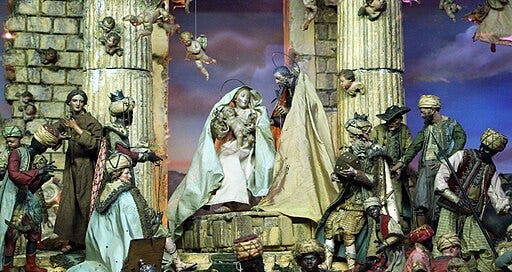Belle Parole: Presepe
A word that takes us into one of Italy's most cherished traditions: the sacred nativity scene.
This Christmas, I thought of sharing a word that holds a special place in the hearts of Italians: presepe.
This word derives from the Latin prae (“in front of”) and saeps (“enclosure”), meaning manger or animal enclosure, evoking the humility and simplicity of the place where, according to Christian tradition, Jesus was born.
In English: nativity (scene).
In Italy, the tradition of setting up the nativity scene during the Christmas season is ancient and is linked to the sacred plays performed in churches, particularly the living nativity scene recreated in 1223 by Saint Francis in Greccio, in the province of Rieti.
Here is how Saint Francis’ nativity scene is described in the Legenda Maior, the biography of St. Francis written by Bonaventura da Bagnoregio in the second half of the 13th century (here translated into English from the original Latin):
It happened, however, in the third year before his death, that he decided to commemorate the nativity of the child Jesus at the castle of Greccio, to stir up devotion with as much solemnity as he could.
To ensure that this could not be considered a novelty, he sought and obtained permission from the Supreme Pontiff to prepare a manger, bring in hay, and have an ox and a donkey led to the place.
The brothers were summoned, the people gathered, the forest echoed with voices, and that venerable night was made resplendent and solemn with abundant lights, clear songs of praise, and harmonious hymns.
The man of God stood before the manger, filled with piety, drenched in tears, and overflowing with joy.
The solemn celebration of Mass was held over the manger, with the Levite of Christ, Francis, chanting the holy Gospel.
Then he preached to the people standing around about the birth of the poor King, whom, in the tenderness of his love, he would call the child of Bethlehem whenever he mentioned Him.
The Greccio nativity scene of St. Francis frescoed by Giotto in the Basilica of San Francesco D’Assisi in Assisi (1297-1300).
Today, the tradition of nativity scenes remains alive and well: just think of the splendid Neapolitan art of presepi, with their intricate settings and rich repertoire of iconic characters, such as Benino, the sleeping shepherd.
Sailko, Presepe napoletano del museo di arte sacra di San Paolo 16, CC BY 3.0
Here’s what J.W. Goethe recounted in 1817 about Neapolitan presepi:
(…) I have forgotten to tell you about another characteristic of the Neapolitans, their love of crèches, or presepe, which, at Christmas, can be seen in all their churches. These consist of groups of large, sumptuous figures representing the adoration of the shepherds, the angels and the three Magi. In this gay Naples the representation has climbed up on to the flat roof tops. A light framework, like a hut, is decorated with trees and evergreen shrubs. In it, the Mother of God, the Infant and all the others stand or float, dressed up most gorgeously in a wardrobe on which the family spends a large sum. The background – Vesuvius and all the surrounding countryside – gives the whole thing an incomparable majesty.
In depicting this sacred scene, it is possible that living figures were sometimes substituted for the dolls, and that in time this gave rise to one of the great diversions of noble and wealthy families, who pass many evenings in their palaces representing profane scenes from history or poetry.
(Italian Journey: 1786-1788 as translated by W.H. Auden and E. Mayer)
If you want to learn more about the tradition of presepi, here are two very interesting links for you to explore:
History | December 20, 2022 What Nativity Scenes Tell Us About the Evolution of Christianity
Wishing you all a very Merry Christmas!







Buon Natale, carissima Substacker, ti auguro una giornata suggestiva come un presepe napoletano e luminosa come la cometa dei Magi!